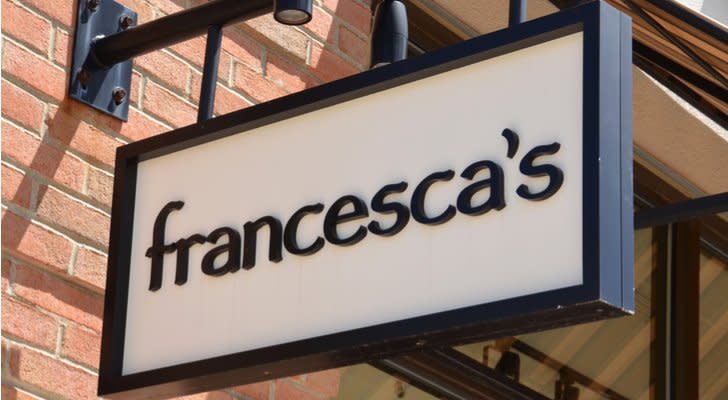5 Retail Stocks That Could Follow in Sears’ Footsteps
It finally happened. After several years of shrinking sales and running up huge losses against a debt-burdened balance sheet, Sears (NASDAQ:SHLD) finally filed for bankruptcy in mid-October 2018.
That’s a big deal. Although we all saw this coming, it is nonetheless sad to say goodbye to a retailer that forever changed America. Once upon a time, Sears helped America become a healthy economy again in the post-War years. The company was a pioneer for massive mall expansion, and re-shaped retail to what it was before the internet came along. And, during all this, Sears became one of the biggest and most powerful retailers in the world.
Back then, no one would’ve guessed that Sears would file for bankruptcy before 2020. But, here we are, and Sears is filing for bankruptcy. It makes you wonder. Who could be next? Are my retail stocks really all that safe?
InvestorPlace - Stock Market News, Stock Advice & Trading Tips
Without a doubt, Sears will not be the final retail stock to go under. E-commerce still only represents roughly 10% of total retail sales. Presumably, that number will head higher over time. As it does, more traditional retailers will suffer, and some will follow Sears into the retail graveyard.
Which retail stocks are likely candidates to be the next Sears? Let’s take a closer look.
Retail Stocks That Could Be The Next Sears: J.C. Penney (JCP)
Source: Shutterstock
Of all the retailers out there, the one most likely to follow in the bankruptcy footsteps of Sears is J.C. Penney (NYSE:JCP).
Sears was a situation defined by sluggish sales and margin trends that led to sizable losses, and a debt-loaded balance sheet which put a time limit on how long the company could run at a loss. JCP is the exact same thing. Sales trends have been sluggish for the past several years, with comparable sales coming in essentially flat in 2016 and 2017, and only narrowly rising in 2018 against a robust consumer backdrop. Meanwhile, gross margins have dropped from 36% in 2015 to roughly 33% today, and the company has had a tough time showing a profit over the past several years.
While operations are deteriorating and losses are piling up, JCP is dealing with a balance sheet burdened by nearly $4 billion in debt. To put that in perspective, adjusted EBITDA was under $1 billion last year, and is rapidly falling this year. If year-to-date trends persist, adjusted EBITDA will come in this year just over $550 million. Therefore, if current trends persist, JCP could be looking at a debt-to-EBITDA ratio of over 7 by the end of the year.
In other words, JCP is turning out to be Sears 2.0. There is some hope for this retailer under the guidance of a new CEO. If the company revamps its stores and accelerates e-commerce initiatives, the numbers could improve and JCP stock could jump. But, it will be hard for JCP to do this while trying to pay off debt, and it increasingly looks like the whole retail scene has moved on from JCP.
Overall, JCP stock looks doomed to follow in the footsteps of SHLD stock.
Retail Stocks That Could Be The Next Sears: Bed Bath & Beyond (BBBY)
Source: Mike Mozart via Flickr
Although Bed Bath & Beyond (NASDAQ:BBBY) doesn’t have the same debt problems as Sears and J.C. Penney, the consumer staples retailer nonetheless finds itself in a situation where tomorrow is not a given.
Bed Bath & Beyond’s numbers have been horrible over the past several years. Comparable sales dropped 0.6% in 2016, and dropped another 1.4% in 2017. So far in 2018, they are down another 0.6%. Meanwhile, margins are dropping big. Back in 2013, this was a company with 40% gross margins, 14% operating margins, and over $1 billion in profits. Over the past twelve months, BBBY’s gross margins have dropped to 35%, operating margins have dropped to 5%, and profits have dropped to $350 million.
The balance sheet isn’t that much of a problem. Cash is growing, and debt levels are reasonable. But, until profits turn around, BBBY stock will continue to drop. I don’t see an operational turnaround materializing any time soon. It appears the retail market has moved on from BBBY. Low-price competitors Walmart (NYSE:WMT), Target (NYSE:TGT), Amazon (NASDAQ:AMZN) and Wayfair (NYSE:W) have encroached on BBBY’s territory. And the only reason the consumer is still going to BBBY is because the retailer is utilizing a coupon heavy strategy. But margins don’t have much more room to fall (operating margins were 2.7% last quarter). Thus, we might be at a tipping point where BBBY stops running discounts, and starts losing traffic.
Having said all that, BBBY stock could stage a huge turnaround if this company somehow manages to drive traffic growth without cutting prices. BBBY does operate in its own niche, and if you assume that consumers prefer shopping at BBBY for consumer staples as opposed to Walmart, Target, or Amazon, then BBBY should be able to curtail coupons and sustain traffic volume. But, I don’t think that’s case.
Instead, I think the BBBY of tomorrow will be much smaller than the BBBY of today. Because of this, BBBY stock is one of the retail stocks following in Sears’ footsteps.
Retail Stocks That Could Be The Next Sears: Pier 1 (PIR)
Source: Mike Mozart via Flickr
Much like Bed Bath & Beyond, Pier 1 (NYSE:PIR) has been hampered by abysmal operating performance which hasn’t improved or even stabilized amid what has a been a massive turnaround in traditional retail over the past 12-plus months.
Comparable sales growth at Pier 1 has been sluggish for the past several years. And as retail started to turn around over the past 2-3 quarters, Pier 1’s comparable sales trajectory has actually worsened. Three quarters ago, Pier 1 comparable sales dropped 7.5%. Two quarters ago, they dropped 8.2%, and last quarter, they fell back 11.4%. Meanwhile, most other retailers have reported positive and improving comparable sales trends during the past 2-3 quarters.
In other words, Pier 1 hasn’t bounced with the rest of the retail. Instead, it is going in the other direction, and that is a sign that even as traditional retail finds a balance with e-retail, there isn’t much room for Pier 1. As such, comparable sales going forward are a big question mark, and that is a big problem because the company is no longer profitable and has more debt on its balance sheet than cash. A debt-loaded balance sheet on a retailer running losses and struggling to turn things around sounds a lot like Sears.
Relative to the other retailers on this list, Pier 1 is more likely to execute a turnaround. The company sells home furnishings which are largely unique to Pier 1, and thereby constitute a product moat for the company. As such, there is an opportunity for both sales and margins to stabilize at some anemic level. Stabilization at even an anemic level will shoot PIR stock markedly higher.
But, the odds are still stacked against Pier 1 and PIR stock. As such, PIR stock appears to be following in the profit erosion footsteps of SHLD stock.
Retail Stocks That Could Be The Next Sears: Francesca’s (FRAN)
Source: Shutterstock
The turnaround at Francesca’s (NASDAQ:FRAN) was underway. Until it wasn’t. Now, FRAN stock finds itself at fresh 52-week lows.
Francesca’s is a women’s fashion retailer who was once the envy of everyone in the retail world. Earlier in the decade, Francesca’s was growing comparable sales at a rate that was unrivaled by anyone in the industry. That led to over confidence, and management started expanding the real estate footprint at a robust rate, assuming that FRAN’s popularity would never waver.
Eventually, it did waver. By a lot. Comparable sales dropped 11% in 2017, and are down another 13%-plus so far this year. The drop in popularity has coincided with a drop in gross margins. To make matters worse, the expense rate is rising dramatically because management grew its real estate footprint too quickly and with too much confidence. The net result is a once-popular retailer that is now struggling to grow sales and running at anemic profit margins.
Of all the retail stocks on this list, Francesca’s is the most likely to successfully execute a turnaround. The balance sheet is clean, and the company is still profitable. Those are big divergences from most everyone else on this list. Moreover, Francesca’s youth, free-spirit oriented marketing seems to have a place in today’s retail environment, and it does appear from ground-level observations that Francesca’s has staying power.
Overall, while FRAN is struggling today much like SHLD did over the past several years, bankruptcy is an unlikely outcome for FRAN. Instead, this is simply a retailer that is struggling right now, and FRAN does have an opportunity turn things around in the foreseeable future.
Retail Stocks That Could Be The Next Sears: Big 5 Sporting Goods (BGFV)
Source: Shutterstock
Sears crumbled because of consistently deteriorating operations and a troubled balance sheet that put a time limit on turnaround efforts. It looks like the same two things could caused the downfall of Big 5 Sporting Goods (NASDAQ:BGFV).
There was a wave of bankruptcies in the sporting goods sector which allowed Big 5 to put up decent numbers in 2015 and 2016. But, that tailwind suddenly ended, and Big 5 had nothing to fall back on. In 2017, comparable sales dropped 1.2%. The decline has only worsened in 2018, with comparable sales dropping 7.5% in 1Q18 and 2.1% in 2Q18. Meanwhile, gross margins are dropping and the SG&A rate is rising, so overall profit margins are getting axed to anemic levels.
The other big problem here is that the balance sheet is loaded with debt. The company had about $6 million in cash on the balance sheet last quarter. Long-term debt measured in at over $90 million. In other words, you have the exact same dynamic playing out at BGFV that dragged SHLD to the grave: sluggish operational results and a debt-burdened balance sheet.
I don’t see much of a turnaround materializing for Big Five. The whole sporting goods retail sector is shifting from wholesale to direct, as brands like Nike (NYSE:NKE) and Adidas (OTCMKTS:ADDYY) are focusing on direct sales and narrowing their wholesale distribution strategy. It is likely that BGFV, given its lack of brand power and scale, eventually gets axed in that wholesale narrowing process.
As such, it looks like Big Five only has a few years left in its tank before the entire world sporting goods retail stocks moves on without it.
As of this writing, Luke Lango was long WMT and AMZN.
More From InvestorPlace
The post 5 Retail Stocks That Could Follow in Sears’ Footsteps appeared first on InvestorPlace.






